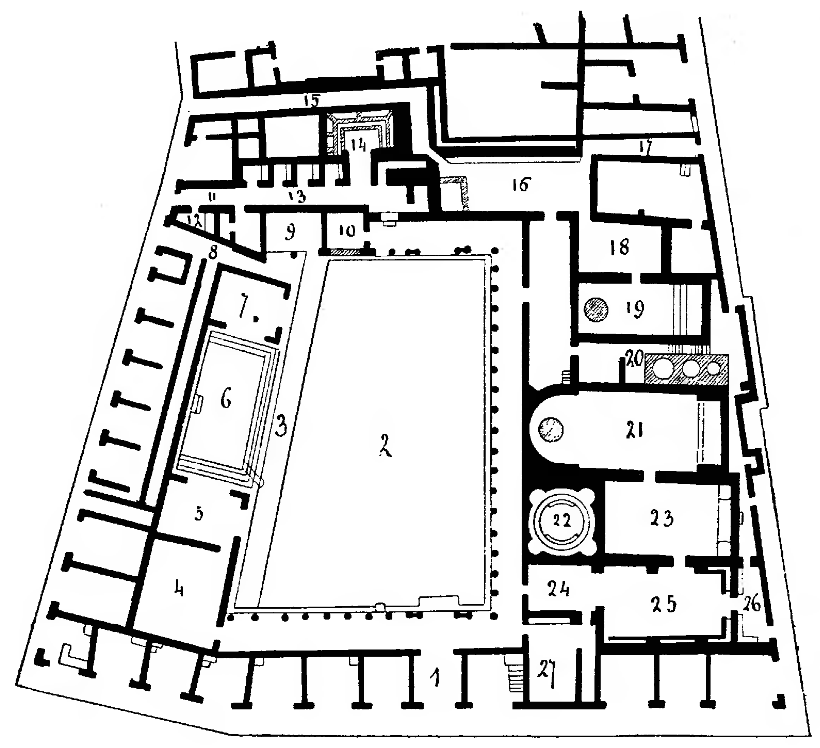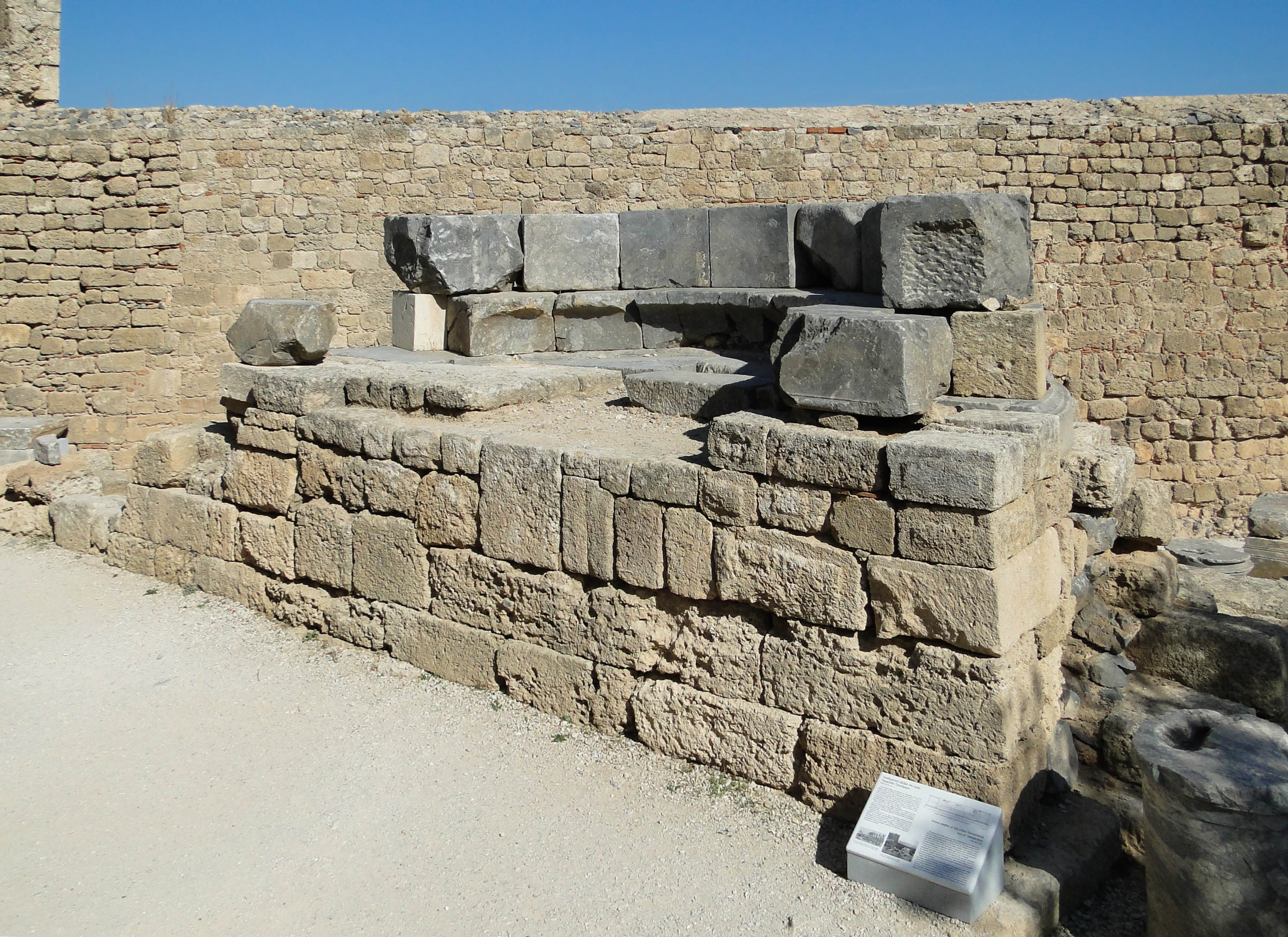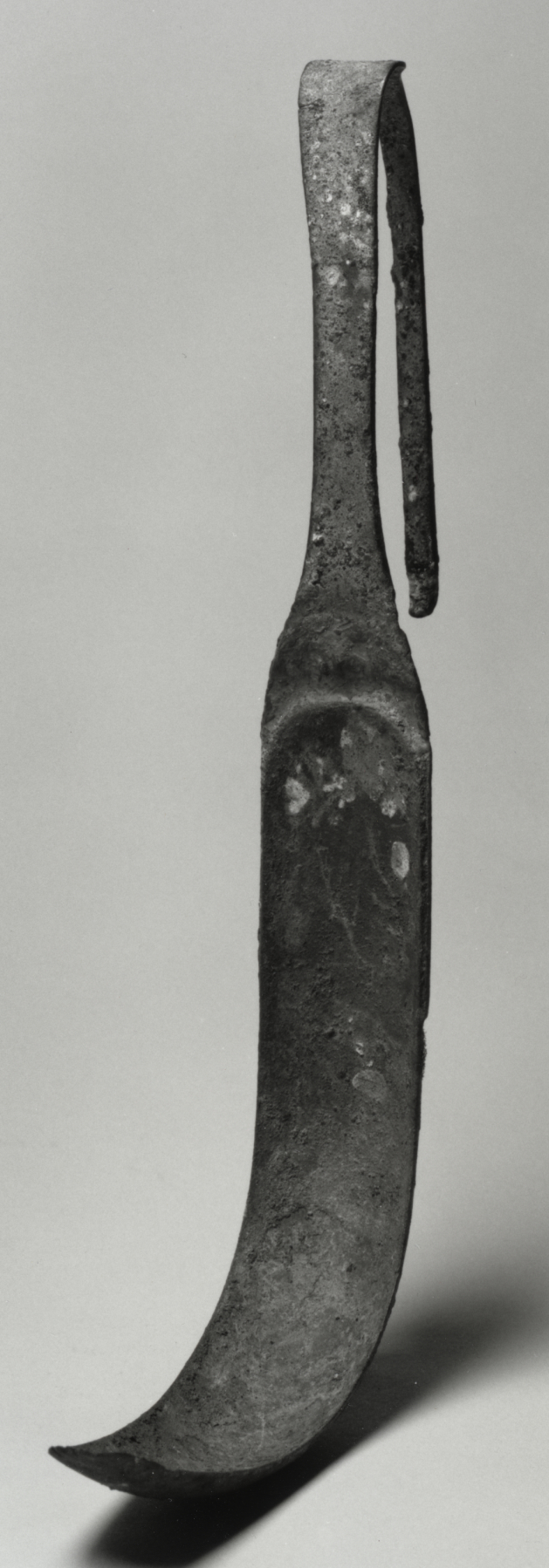|
Stabian Baths
The Stabian Baths are an ancient Roman bathing complex in Pompeii, Italy, the oldest and the largest of the 5 public baths in the city. Their original construction dates back to ca. 125 BC, making them one of the oldest bathing complexes known from the ancient world. They were remodeled and enlarged many times up to the eruption of Vesuvius in 79 AD. Description The Stabian Baths are located off the intersection of two main streets in Pompeii: the ''Via dell'Abbondanza'' to the south and the ''Via Stabiana'' to the east (the latter gives them their modern name). On the west side, the baths are bordered by the ''Vicolo del Lupanare'', and to the north by the house of P. Vedius Siricus. As was typical of ancient Roman bathhouses, the facilities were divided by sex. The main entrance was from the ''Via dell'Abbondanza'', through a vestibule (1) into the ''palaestra'' (2), a large open-air exercise ground. A row of shops fronted the street. On the right-hand side of the ''palaestr ... [...More Info...] [...Related Items...] OR: [Wikipedia] [Google] [Baidu] |
Pompeii
Pompeii (, ) was an ancient city located in what is now the ''comune'' of Pompei near Naples in the Campania region of Italy. Pompeii, along with Herculaneum and many villas in the surrounding area (e.g. at Boscoreale, Stabiae), was buried under of volcanic ash and pumice in the Eruption of Mount Vesuvius in 79 AD. Largely preserved under the ash, the excavated city offered a unique snapshot of Roman life, frozen at the moment it was buried, although much of the detailed evidence of the everyday life of its inhabitants was lost in the excavations. It was a wealthy town, with a population of ca. 11,000 in AD 79, enjoying many fine public buildings and luxurious private houses with lavish decorations, furnishings and works of art which were the main attractions for the early excavators. Organic remains, including wooden objects and human bodies, were interred in the ash. Over time, they decayed, leaving voids that archaeologists found could be used as moulds to make plast ... [...More Info...] [...Related Items...] OR: [Wikipedia] [Google] [Baidu] |
Labrum (architecture)
The labrum in architecture was a large water-filled vessel or basin with an overhanging lip. Marble labrums were a common feature of Roman thermae. Examples File:3797 - Milano - Duomo - Fonte battesimale in vasca romana - Foto Giovanni Dall'Orto - 9-July.-2007.jpg, Labrum in Milan File:RA GdT Wanne Frontseite Juni 2010-22.JPG, Labrum in Mausoleum of Theodoric in Ravenna File:Rom, San Giovanni in Lateran, Innenraum des Baptisteriums 2.jpg, Lateran Baptistery Rome File:Interior - Basilica di San Bartolomeo all'Isola - Rome, Italy - DSC00465.jpg, San Bartolomeo all'Isola, Rome File:Museo Pio-Clementino bath 2.jpg, Pio-Clementino Museum Vatican File:Badewanne (Caracalla-Thermen).jpg, Labrum from Baths of Caracalla Vatican museum See also * Roman technology Roman technology is the collection of antiques, skills, methods, processes, and engineering practices which supported Roman civilization and made possible the expansion of the economy and military of ancient Rome (753 BC � ... [...More Info...] [...Related Items...] OR: [Wikipedia] [Google] [Baidu] |
Ancient Roman Baths In Italy
Ancient history is a time period from the beginning of writing and recorded human history to as far as late antiquity. The span of recorded history is roughly 5,000 years, beginning with the Sumerian cuneiform script. Ancient history covers all continents inhabited by humans in the period 3000 BCAD 500. The three-age system periodizes ancient history into the Stone Age, the Bronze Age, and the Iron Age, with recorded history generally considered to begin with the Bronze Age. The start and end of the three ages varies between world regions. In many regions the Bronze Age is generally considered to begin a few centuries prior to 3000 BC, while the end of the Iron Age varies from the early first millennium BC in some regions to the late first millennium AD in others. During the time period of ancient history, the world population was already exponentially increasing due to the Neolithic Revolution, which was in full progress. While in 10,000 BC, the world population stood ... [...More Info...] [...Related Items...] OR: [Wikipedia] [Google] [Baidu] |
Buildings And Structures Completed In The 2nd Century BC
A building, or edifice, is an enclosed structure with a roof and walls standing more or less permanently in one place, such as a house or factory (although there's also portable buildings). Buildings come in a variety of sizes, shapes, and functions, and have been adapted throughout history for a wide number of factors, from building materials available, to weather conditions, land prices, ground conditions, specific uses, prestige, and aesthetic reasons. To better understand the term ''building'' compare the list of nonbuilding structures. Buildings serve several societal needs – primarily as shelter from weather, security, living space, privacy, to store belongings, and to comfortably live and work. A building as a shelter represents a physical division of the human habitat (a place of comfort and safety) and the ''outside'' (a place that at times may be harsh and harmful). Ever since the first cave paintings, buildings have also become objects or canvasses of much artisti ... [...More Info...] [...Related Items...] OR: [Wikipedia] [Google] [Baidu] |
AD 62 Pompeii Earthquake
On 5 February AD 62, an earthquake of an estimated magnitude of between 5 and 6 and a maximum intensity of IX or X on the Mercalli scale struck the towns of Pompeii and Herculaneum, severely damaging them. The earthquake may have been a precursor to the eruption of Mount Vesuvius in AD 79, which destroyed the same two towns. The contemporary philosopher and dramatist Seneca the Younger wrote an account of the earthquake in the sixth book of his '' Naturales quaestiones'', entitled ''De Terrae Motu'' (''Concerning Earthquakes''). Geological setting The epicentre of the earthquake lies within a zone of active extensional faulting, but close to the southern flank of Vesuvius. Analysis of focal mechanisms from the area around Vesuvius indicates that active faulting in the area involves NW–SE and NE–SW trending oblique-slip normal faults and E–W trending normal faults, part of the zone of active extension that extends the full length of the Apennines mountain chain, associated ... [...More Info...] [...Related Items...] OR: [Wikipedia] [Google] [Baidu] |
Exedra
An exedra (plural: exedras or exedrae) is a semicircular architectural recess or platform, sometimes crowned by a semi-dome, and either set into a building's façade or free-standing. The original Greek sense (''ἐξέδρα'', a seat out of doors) was applied to a room that opened onto a stoa, ringed with curved high-backed stone benches, a suitable place for conversation. An exedra may also be expressed by a curved break in a colonnade, perhaps with a semicircular seat. The exedra would typically have an apsidal podium that supported the stone bench. The free-standing (open air) exedra, often supporting bronze portrait sculpture, is a familiar Hellenistic structure, characteristically sited along sacred ways or in open places in sanctuaries, such as at Delos or Epidaurus. Some Hellenistic exedras were built in relation to a city's agora, as in Priene. Monument architects have also used this free-standing style in modern times. Rise The exedra achieved particular popula ... [...More Info...] [...Related Items...] OR: [Wikipedia] [Google] [Baidu] |
Loggia
In architecture, a loggia ( , usually , ) is a covered exterior gallery or corridor, usually on an upper level, but sometimes on the ground level of a building. The outer wall is open to the elements, usually supported by a series of columns or arches. They can be on principal fronts and/or sides of a building and are not meant for entrance but as an outdoor sitting room."Definition of Loggia" Lexic.us. Retrieved on 2014-10-24. An overhanging loggia may be supported by a . From the early , nearly every Italian |
Strigil
The strigil ( el, στλεγγίς, translit=stlengis, probably a loanword from Pre-Greek substrate) is a tool for the cleansing of the body by scraping off dirt, perspiration, and oil that was applied before bathing in Ancient Greek and Roman cultures. In these cultures the strigil was primarily used by men, specifically male athletes; however, in Etruscan culture there is some evidence of strigils being used by both sexes. The standard design is a curved blade with a handle, all of which is made of metal. Strigils were commonly used by individuals who were engaging in vigorous activities, in which they accumulated large amounts of dirt and sweat on their bodies. The people who used the strigil included athletes, the wealthy, soldiers, and more. However, wealthy or prestigious individuals often had slaves to wield the strigils and clean their bodies, rather than doing it themselves. Strigils were not only significant in a practical sense, but culturally as well. They are oft ... [...More Info...] [...Related Items...] OR: [Wikipedia] [Google] [Baidu] |
Laconicum
The ''laconicum'' (i.e. Spartan, ''sc.'' ''balneum'', bath). Cf. Greek ''pyriaterion to lakonikon'' "the Laconian vapour-bath"; , . was the dry sweating room of the Roman ''thermae'', contiguous to the ''caldarium'' or hot room. The name was given to it as being the only form of warm bath that the Spartans admitted. The ''laconicum'' was usually a circular room with niches in the axes of the diagonals and was covered by a conical roof with a circular opening at the top, according to Vitruvius (v. 10), from which a brazen shield is suspended by chains, capable of being so lowered and raised as to regulate the temperature. It is similar to a sudatorium, or steam bath, where water is added to produce steam. Sometimes, as in the old baths at Pompeii, the ''laconicum'' was provided in an apse at one end of the ''caldarium'', but as a rule it was a separate room raised to a higher temperature and had no bath in it. In addition to the hypocaust under the floor, the wall was lined wi ... [...More Info...] [...Related Items...] OR: [Wikipedia] [Google] [Baidu] |
Duumviri
The duumviri (Latin for "two men"), originally duoviri and also known in English as the duumvirs, were any of various joint magistrates of ancient Rome. Such pairs of magistrates were appointed at various periods of Roman history both in Rome itself and in the colonies and '' municipia''. ''Duumviri iuri'' or ''iure dicundo'' were the highest judicial magistrates in the cities of Italy and its provinces. Their chief duties were concerned with the administration of justice. The activities of these individuals are described in the local statutes such as ''Lex Julia'', '' Lex Irnitana'', '' Lex Malacitana'', ''Lex Rubria'', ''Lex Coloniae'', and ''Genetivae Iuliae''. The office was determined by election and lasted one year. They were also expected to deal with public finance of a city, deal with proceedings in the Ordo decurionum, the town council, and run the elections in the comitium or assembly. Combined with the ''aediles'', they formed the ''quattuorviri'', a board of four off ... [...More Info...] [...Related Items...] OR: [Wikipedia] [Google] [Baidu] |
Roman Colony
A Roman (plural ) was originally a Roman outpost established in conquered territory to secure it. Eventually, however, the term came to denote the highest status of a Roman city. It is also the origin of the modern term '' colony''. Characteristics Under the Roman Republic, which had no standing army, bodies of their own citizens were planted in conquered towns as a kind of garrison. There were two types: * Roman colonies, ''coloniae civium Romanorum'' or ''coloniae maritimae'', as they were often built near the sea, e.g. Ostia (350 BC) and Rimini (268 BC). The colonists consisted of about three hundred Roman families and were given a small plot of land so were probably small business owners. * Latin colonies (''coloniae Latinae'') were considerably larger than Roman colonies. They were military strongholds near or in enemy territory. The colonists were given large estates up to 35 hectares. They lost their citizenship which they could regain if they returned to Rome. ... [...More Info...] [...Related Items...] OR: [Wikipedia] [Google] [Baidu] |
Sitz Bath
A sitz bath or hip bath is a bath in which a person sits in water up to the hips. It is used to relieve discomfort and pain in the lower part of the body, for example, due to hemorrhoids (piles), anal fissures, perianal fistulas, rectal surgery, an episiotomy, uterine cramps, inflammatory bowel disease, pilonidal cysts and infections of the bladder, prostate or vagina. It works by keeping the affected area clean and increasing the flow of blood to it. Such hip baths were originally a European custom,. although modern sitz baths are used mainly for therapeutic purposes. The term ''sitz bath'' is derived from the German word ''Sitzbad'', meaning a bath (''Bad'') in which one sits (''sitzen''). Preparation A sitz bath may be created simply by filling a bathtub with some water and sitting in it for a few minutes. Alternatively, a large basin can be used. There are also special devices that fit into toilet bowls. Sitz baths may either be warm or cool, or alternating between the two ... [...More Info...] [...Related Items...] OR: [Wikipedia] [Google] [Baidu] |








